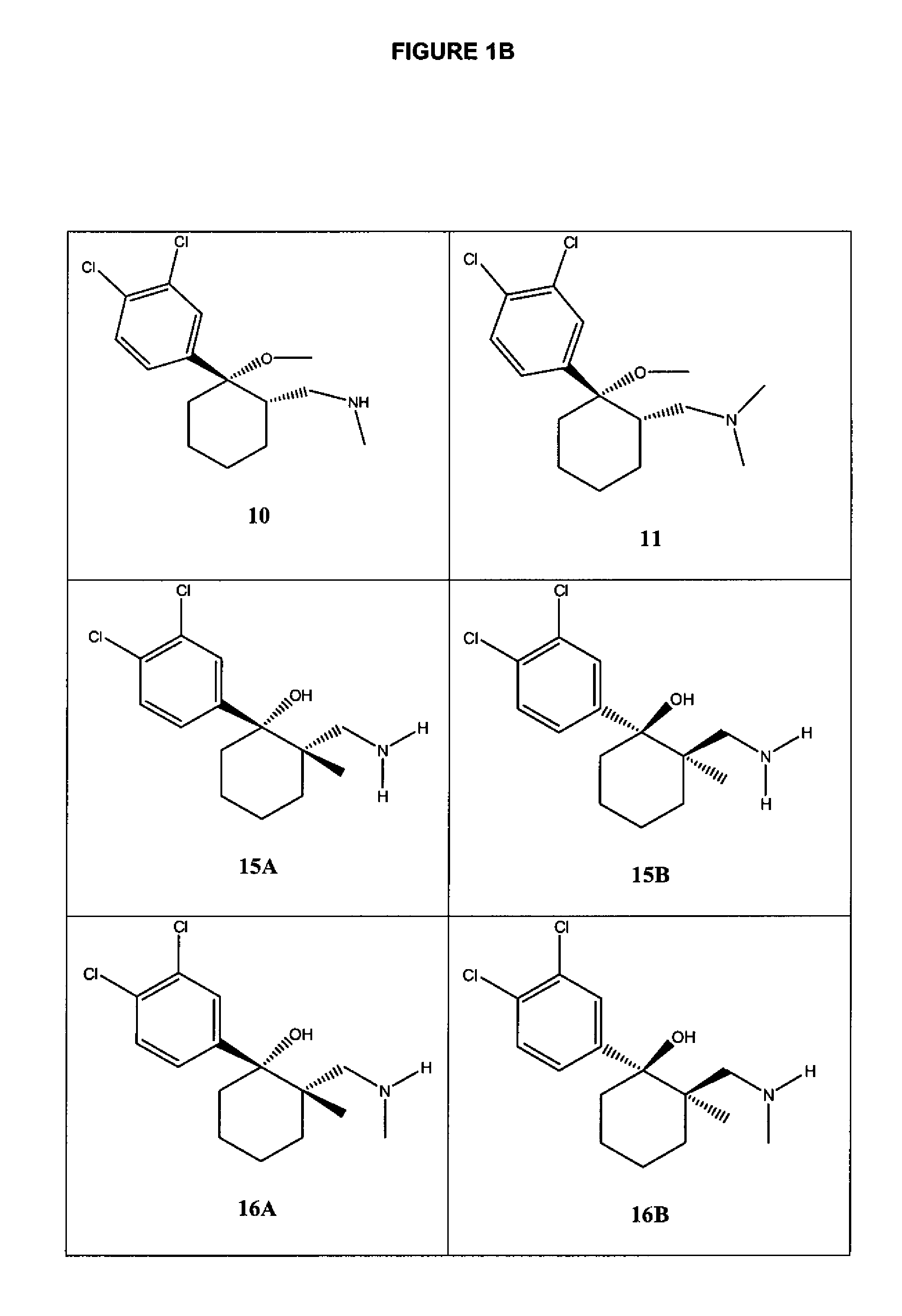Phenyl substituted cycloalkylamines as monoamine reuptake inhibitors
a technology of monoamine reuptake inhibitor and cycloalkylamine, which is applied in the field of compound and composition for the treatment of neurological disorders, can solve the problems of affecting many psychiatric diseases remain untreated or inadequately treated with current pharmaceutical agents, and side effects that can greatly influence the overall outcome of therapy. , to achieve the effect of inhibiting the activity
- Summary
- Abstract
- Description
- Claims
- Application Information
AI Technical Summary
Benefits of technology
Problems solved by technology
Method used
Image
Examples
example 1
1a. General Procedures
[0229]In the examples, below, the following general experimental procedures were used unless otherwise noted: All commercial reagents were used without further purification. Anhydrous reactions were performed in flame-dried glassware under N2. NMR spectra were recorded on a Varian 400 MHz spectrometer in deuterochloroform or methanol-d4 with trimethylsilane (TMS) as an internal reference. Silica gel column chromatography was performed using an ISCO Combiflash system with detection at 254 nm or using ISCO normal phase silica gel cartridges.
1b. Analytical HPLC
[0230]Analytical HPLC was performed on a Hewlett Packard Series 1100 pump connected to an Agilent Zorbax RX-C18 5 μm, 4.6×250 mm column, with detection on a Hewlett Packard Series 1100 UV / Vis detector monitoring at 214 and 254 nm. Typical flow rate=1 ml / min. Three different HPLC columns and various elution protocols were used. For example, (1) Agilent Zorbax RX-C18 5 μm, 4.6×250 mm column running a linear gr...
example 2
2a. Experimental Procedures and Characterization Data
[0235]
[0236]To a solution of ketone a (2.0 g, 13 mmol) in THF (20 mL) at −78° C. was added 3,4-dichlorophenylmagnisium bromide (0.5 M in THF, 38 mL, 19 mmol). The reaction mixture was stirred for 30 min at −78° C. before being warmed to 0° C. over 30 min. A saturated solution of NH4Cl (30 mL) was added to the reaction mixture to quench the reaction. The resulting product was extracted with diethyl ether (2×100 mL). The combined extracts were dried and concentrated. The residue was subjected to silica gel column chromatography (ethyl acetate / hexane / Et3N=1:10:0.1) to give the racemic mixture of 1 and 2 (3.5 g, 90%). The racemic mixture was separated by chiral AD column (hexane / iPrOH / DEA=95 / 5 / 0.1 as eluent) to give pure 1 (Faster moving enantiomer) and 2 (Slower moving enantiomer).
2a1. Data For 1 / 2
[0237]1H NMR (400 MHz, CD3OD) δ 7.73 (d, J=1.6 Hz, 1H), 7.52 (d, J=8.4 Hz, 1H), 7.47 (dd, J=1.6, 8.4 Hz, 1H), 3.01 (dd, J=13.2, 10.4 Hz, 1...
example 3
3a. Experimental Procedures
[0250]
[0251]Experimental conditions utilized for these syntheses were similar to those employed in Examples 1 and 2.
[0252]
[0253]Experimental conditions utilized for these syntheses were similar to those employed in Examples 1 and 2.
PUM
| Property | Measurement | Unit |
|---|---|---|
| enantiomeric excess | aaaaa | aaaaa |
| enantiomeric excess | aaaaa | aaaaa |
| enantiomeric excess | aaaaa | aaaaa |
Abstract
Description
Claims
Application Information
 Login to View More
Login to View More - R&D
- Intellectual Property
- Life Sciences
- Materials
- Tech Scout
- Unparalleled Data Quality
- Higher Quality Content
- 60% Fewer Hallucinations
Browse by: Latest US Patents, China's latest patents, Technical Efficacy Thesaurus, Application Domain, Technology Topic, Popular Technical Reports.
© 2025 PatSnap. All rights reserved.Legal|Privacy policy|Modern Slavery Act Transparency Statement|Sitemap|About US| Contact US: help@patsnap.com



